
"It's
always nice to be appreciated…"
Interview with Michael
Golden Part 1
|
When you hear the name Michael Golden mentioned in the context of comics, many images probably come to mind. Maybe you think of his work on Bucky O'Hare. Maybe you think of his work on The 'Nam, G.I. Joe, Dr. Strange or as the co-creator of the X-man character Rouge. Or maybe you just remember him as the guy who drew thousands of amazing cover images for Marvel Comics in the late 70's and early 80's. One thing is for certain though, when Michael's name is discussed in the context of comics, the word "Micronauts" is always mentioned in the same breath. Although his stint on
the Marvel series only lasted 12 issues, he is forever considered "the"
Micronauts artist far above and beyond all those that came after him.
He continued to keep his name attached to the property and his rep as
a stellar artist cemented by supplying some of the most incredible cover
work ever produced during the series. But according to him," I
just like telling stories. It doesn't matter what it is…I'll do my best
at any given point no matter what the character is." |
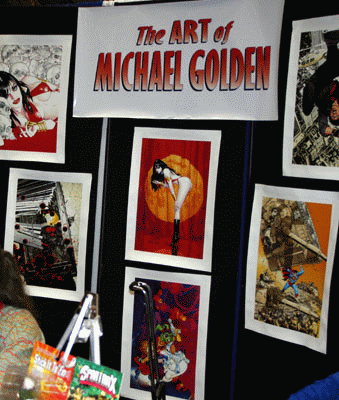 |
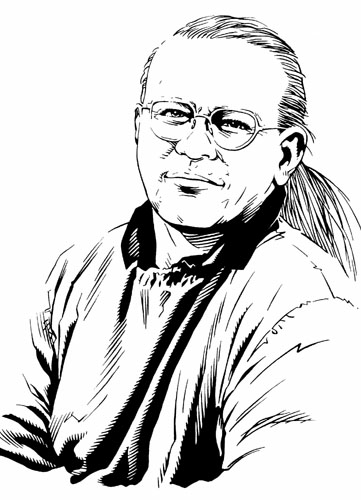 self portrait © 2007 Michael Golden |
ISO:
So the Baltimore Comic Con this past September was the first comic convention
you've done in a few years, correct?
Michael Golden:
Yup…I went to a con in the mid 90's, so it's been about 10/15 years…
ISO: Is there a reason you decided to get back into doing shows? MG: Well, I want to tell stories. I want to get back to doing graphic narratives/comic book sort of stories, and my understanding is that the nature of the industry is such that the only real way to get from point A to point B is to present this stuff in a personal context, I.E.: as a personality. ISO: So getting back "out on the road"… MG: Yeah, this is just a means to an end. ISO: How have the shows been going for you? You've done a few more since Baltimore? MG: The shows have been rather successful. My presence has been tolerated! (laughs) Renee Witterstaetter (Michael's manager): Since we've announced Michael is on the circuit again and is doing shows, I have been inundated with requests. I have more requests for time than Michael has in the next two years! Not just domestic conventions, but international as well. Every major convention, everywhere. ISO: I noticed at the Balto. show a lot of other industry professionals were coming up to you and showering you with praise, telling you how much of an influence you were on them. Guess that makes you pretty happy, huh? MG: …Yes! (laughs) It's always nice to be appreciated… |
|
|
|
RW: I think Michael's being modest because I do know that these shows we've been to both fans and artists have come up to him and say "you're the reason I became an artist, you're the reason I pursued this career". I think it has been an eye opener to him, I don't think before these past few months he didn't realize he had influenced so many people. What's also interesting is the different niches of fans that are appreciative that have come up to him; the ones that like Micronauts, the ones that like The 'Nam, Dr. Strange…it's been very compartmentalized for the most part. ISO: You do sketches at the shows, have you found that you've been doing more of one character, certain groups of characters more so than others? MG: Baltimore was a lot of Dr. Strange. ISO: …and a few Micronauts sketches while I was there…which is a nice segue into the next batch of questions that concerns the Micronauts. I think the series started in 1978, and Bob Hall was the guy who produced some of the first artwork related to Bill Mantlo's proposal. Can you tell me how you got on board with Micronauts after that point?
ISO: So what exactly did Bill supply you plot-wise? I was under the assumption from reading an old interview with him that the first 12 issues were already plotted out and kind of written and planned… MG: …already worked out? No…the whole thing was made up on the fly. Back then, everything was still done the Stan Lee/Jack Kirby way. It was known as the "Marvel Style"; the writer would produce a plot, the artist would produce the artwork and then the writer would go back in and write the dialogue. Now I had never worked that way before but obviously I must have had a knack for it because it all worked out well, or reasonably so…
ISO: Well for instance in the first issue you drew something called the "Death Tank" which was a part from one toy combined with something you made up, would you go back to the toy box to create something like that?
MG: Well it was the nature of the Micronauts toys that you could make them interchangeable if I remember them correctly, and in that context then yeah, I would go and interchange things to get different visuals. ISO: Did you think that they toys themselves were at least kinda cool reference material to work from? Inspiring at all? MG: (pauses…laughs)…I…just thought of them as things I had to draw. You know, I didn't think of it in terms of an 8 year old kid playing with the stuff, it was more "how and what is the most effective and efficient and expedient way to draw this thing every page". ISO: Did the license holders ever tell you that you had to go and put a certain amount of this or that into the pages of the book? MG: No, not back then. They were just thrilled to have the book out. ISO: Did they just kind of give you free range then? MG: Well, I can't answer that one yes or no. Marvel themselves were more of a stickler on what they wanted than anybody else was. ISO: What directives did they give you? MG:
The directives were basically that it was a "Marvel" book; you have
X amount of action and that action has to be in a certain context,
and the bad guys had to be bad guys, etc…this was Marvel Comics before
all the gray stuff started infiltrating the storylines. |
 |
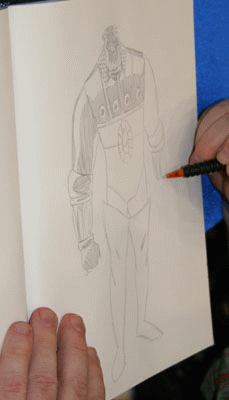 |
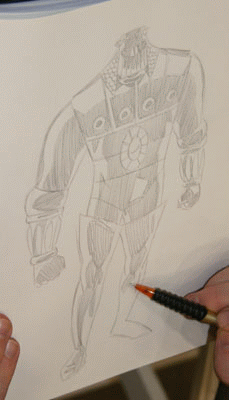 |
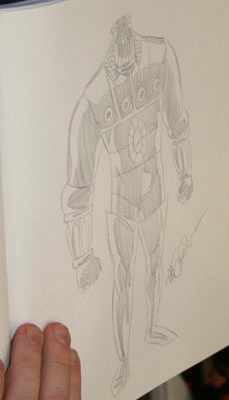 |
|
|
above: evolution of a Baron Karza convention sketch ISO: …gray stuff? MG: By the end of the 70's and into the 80's all of a sudden characters started to change. Change in the sense that good guys were doing bad things and bad guys suddenly had altruistic motives. So instead of everything being black and white, "good guys and bad guys", everything was now gray. The Micronauts was still pretty much black and white then. There were the bad guys and they did bad things and had bad motives, and the good guys - even though they may have been wishy-washy about things every now and again (laughs) - ultimately they were all still good guys. ISO: You worked on the book penciling the first 12 issues…was there a reason you decided not to continue on longer with the series? MG: Yeah…after the first 3 issues I got fed up with some the inherent politics of the time and by the fifth or sixth issue, I forget which one exactly, I just informed them I was gonna leave. And that was it. Then they decided, "well, if Golden's going to go, we need them to wrap up the storyline, and then he can go." ISO: I recall you mentioning that your art style changed a lot from the first issue to the third to the next…was that a part of it? MG: Yes. It was constantly "do it like Kirby, do it like Kirby, do it like Kirby". I finally just gave in and did it like Kirby and everyone was really happy and pleased and… ISO: Everyone except you? MG: Well, I really didn't care one way or the other, its just I have a very low tolerance for stupidity and hypocrisy and just decided I didn't want to deal with all of the political agendas that were going on and that's why I left the book. |
|
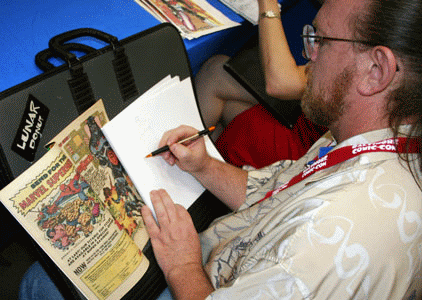 Michael @ the BCC 9.12.06 |
|
ISO: I know you got your start at DC and all, but I think that a lot of fans became aware of you and fell in love with your artwork due to the Micronauts, and it helped you gain the reputation you have today for being such an amazing artist… MG: Well yeah, thanks, I guess I can concede that. I did find out later that Micronauts was a very popular book and so I have to assume that anything that I may have enjoyed out of it was precipitated by being attached to that project. ISO: Do you remember if you came up with anything that was all your idea, or maybe something of Bill's you really expanded on and made it all your own? MG: Well…at the risk of blowing my own horn here, almost all of the characterization was me. I don't recall any of that being in any of the plots. The plots that Bill put out were basically like jigsaw puzzle pieces of action. I was supposed to tie all that together. ISO: Did you come up with any original characters that weren't a part of Bill's original ideas taken from the action figures themselves? Side characters like Slug, Shaitan… |
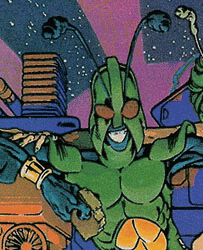
|
|
MG: I made up Bug. Bug was originally a character named Galactic Warrior, which was obviously one of the toys, and what we needed was somebody that was a little more interactive than a guy with a big missile launcher. I mean, we already had a giant robot, etc…so Galactic Warrior sort of transmuted into what Acroyear eventually became, and we just used the Acroyear name and attached some of the visuals to it…so they sort of merged. And I created Bug as sort of the comic relief. He was the smart-ass kind of character that was along for the ride, and we developed that over a period of time. By virtue of attaching himself to people he became loyal to them. That certainly wasn't apart of Bill's staple of characters. I designed the Endeavor space ship, I also made up Marionette. ISO: Yeah, she was another that didn't have a correlating toy. |
|
|
|
MG: The kernel of that character was in fact Bill's, he did want a love interest…that was a part of Bill's staple of characters; there's always this "sexual tension" sort of thing, well it was part of all the Marvel characters actually…I remember he had specified that there was a female character and made up the name "Marionette" after I had created that visual of her dancing underneath the robots arms. I was the one who created the whole dynamic between her and the little robot…what was his name? Microtron. That was supposed to be ongoing by the way, but beyond that initial visual we never did anything with it again. ISO: Did you guys consciously make the Microtron and Biotron characters similar to the R2-D2/C-3PIO robot buddy thing? MG: No, we were thinking Laurel and Hardy, or at least I was.
ISO: Acroyear was a character that was fleshed out very interestingly. The fact that his race was all dark-skinned and he had the evil brother who was an albino, their facial features, they had no nose…did you come up with that? |
RW: Something like that does hurt the integrity of the series. MG: And that wasn't really that much of a stretch, because it really never was the science fiction fantasy adventure that I was told it was originally going to be in the first place. Those concepts were in fact addressed in the first few issues of the book, and had it stayed in that vein I probably would have been much more satisfied. But there were too many other problems associated with that project and make that point moot. |
|
continue to part 2